The Acer Aspire R 13 Review: Convertible Notebook With A Twist
by Brett Howse on June 15, 2015 8:00 AM EST- Posted in
- Laptops
- Acer
- Aspire
- Ultrabook
- Broadwell-U
- Aspire R 13
Display
The display is arguably the most important part of any device, but even more so with a convertible notebook. The rise of tablets have moved the expectations quite far in regards to important metrics like color accuracy and viewing angles. The display is also one of the highest power draws of the system now with the rest of the components all scaling down over the years, and the display power effect can be even more pronounced as the display resolution increases. This is due to the amount of light blocked by the TFT which drives each subpixel. This leaves us with three basic options now.
The first option is to do nothing. The amorphous silicon substrate will block a higher percentage of light, which means the backlight will have to be run at a stronger setting to keep the light output the same. This obviously uses more power though. Another option is to run a RGBW pentile matrix, with an extra white subpixel to help with brightness. This is not ideal though since it can play havoc with color accuracy. The third option right now is to make the TFT out of something more transparent than amorphous silicon, and that is the option Acer has chosen for the R 13. The Sharp IGZO uses an Indium Gallium Zinc Oxide (IGZO) TFT which allows a lot more light through, allowing a less powerful backlight and therefore better battery life. This allows the R 13 to keep a full RGB subpixel arrangement which should help on the color accuracy tests coming up.
The other part of the display though is the screen technology, and it was not that long ago that pretty much all laptops came with Twisted Nematic (TN) panels. These suffered from terrible viewing angles, with contrast falling off almost instantly when viewing was off-centre. However TN panels were both cheap, and have a fast response time. Patterned Vertical Alignment (PVA) and Multi-Domain Vertical Alignment (MVA) offer better viewing angles than TN, generally coming in around 160° of viewing. In-Plane Switching panels offer the greatest viewing angles, with panels having around 178° and suffering the least from off-angle contrast drop off. Pretty much all tablets use IPS displays and there has been a strong push to it in higher end notebooks as well.
The Acer R 13 has two options for displays, with the base model having a 1920x1080 resolution IPS display. The higher end model comes with an upgraded resolution of 2560x1440, but moves from IPS to PVA. This particular PVA seems to struggle more than you would think with off-angle contrast issues, enough that at first I wondered if this was a TN panel. Luckily it is not TN, but the loss of contrast is more noticeable on this display than I am used to. I believe the actual panel is the same one as found in the Acer Aspire S7 Ultrabook, and on a traditional notebook such as that one it would be less noticeable, but on a convertible device like the R 13, you will find yourself using the display at less than optimal viewing angles more often and it is quite obvious that this is not an IPS display.
To measure the display’s color accuracy, brightness, and contrast, we use SpectralCal’s CalMAN 5 suite with a custom workflow. Brightness and contrast measurements are done with the X-Rite i1Display Pro colorimeter, and color accuracy is checked with the X-Rite i1Pro spectrophotometer.
Brightness and Contrast



At around 360 nits maximum brightness, the R 13 is not the brightest device tested but it is a good result regardless. This combined with good black levels results in a very strong 1200:1 contrast ratio when viewed directly like the meters do.
Grayscale and White Point

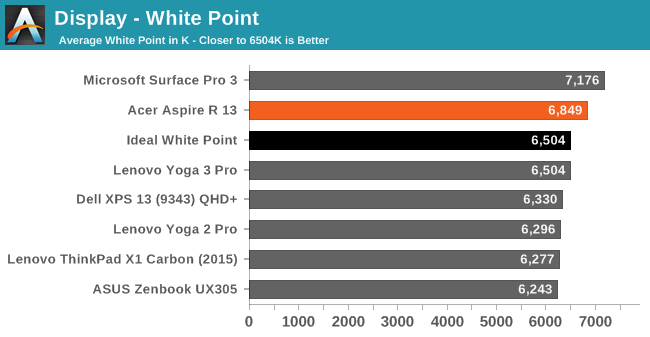
The white point for the R 13 is slightly blue, but not drastically so. Overall grayscale accuracy is over the 3.0 level where errors are visible, however once it gets close to 100% white, the error levels rise dramatically to the point where at 100% white it is around a dE of 12. There was no ICC profile included with this panel which would have helped grayscale at least, and correct the gamma which is too high.
Saturation
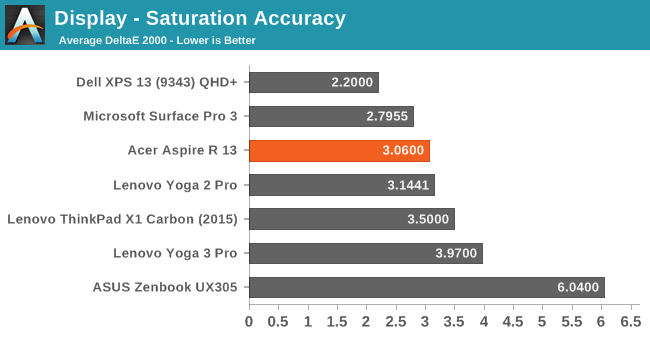
Saturations are a bit better with a dE of right around the 3.0 mark which is the level where errors are visible. According to our testing the display covers 88% of the sRGB gamut. Blue is the one color that is quite a bit oversaturated, with the rest of the primary and secondary colors much closer to where they should be.
GMB
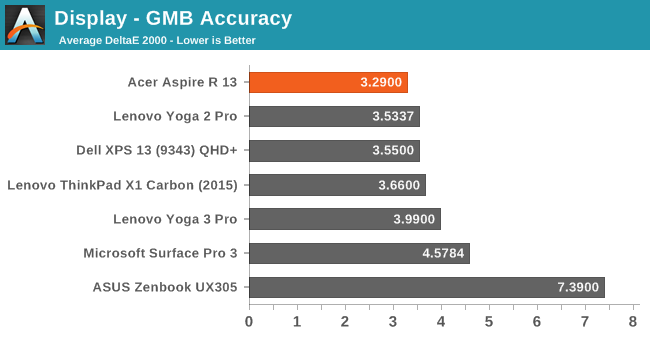
The comprehensive Gretag Macbeth color checker has a good average, once again just over 3.0. This is not the most accurate display we have tested, but it is not so far off to be difficult to use.
Color Checker
We are now going to include the relative color checker to give readers the chance to see just what these numbers mean. On the top is a relative expression of how far off the color is from where it should be. I say relative of course because any inaccuracy in your own monitor will affect the actual differences, but it still gives a good relative explanation for the testing numbers.
You can clearly see that the white levels get very blue, but overall the colors are much closer to where they should be, which is what the testing numbers say as well.
Calibrated
Calibration on a notebook generally helps the most with grayscale, but it can help pull the other colors in a bit as well.
Grayscale is much improved at 1.6 however the 100% white is still very inaccurate. The calibration pulls the other values in as well but are mostly helped out by the improved grayscale.


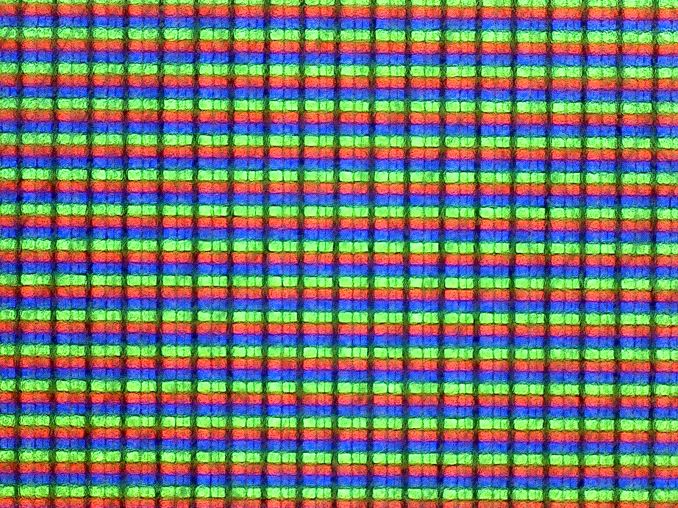
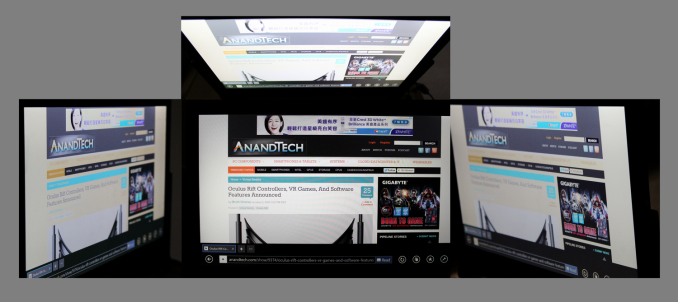
















25 Comments
View All Comments
jabber - Wednesday, June 17, 2015 - link
Well...the main issue is..it's an Acer.No thanks. Seen too much of their bargain basement rubbish with mega bloatware installs.
BMNify - Wednesday, June 17, 2015 - link
Decent ultrabook and gives another type of option to people who don't want Lenovo Yoga style or the standard notebook style of Dell XPS 13.PenguinJim - Wednesday, June 17, 2015 - link
I wish they'd release another in the R7-571 / 572 series - the "proper" R7 series with the keyboard at the front and the touchpad at the back.I hate using touchpads, and only found out when getting my R7 that some people do like them - I'd thought it was a universal hate, for some reason. But the R7 packed in an i5 (laptop, so dual-core, mind) and GT 750M (dedicated GDDR5 version) with a 15.6" 1080P screen (my favourite balance between size/resolution/legibility) and genuinely useful transformation modes, for under $1,000.
I'd hoped they'd release a successor that included a numpad - my one great nitpick with the original. In fact, when I come to replace it in a few years, I'm dreading my options, as having the keyboard at the front and the used-twice-a-month touchpad at the back has been so great for me.
But here they've just aped that old Dell format for hybrid laptops.
snolepard - Sunday, October 25, 2015 - link
I have exactly the same point of view -criticism seemed to mostly come from people trying to use it unconventionally-although to be fair, when in ezel mode, a stylus or a touch app to improve precision without using a mouse was necessary.The failure of market acceptance is one of many examples of the revolutionary failing because the conventional trumps the visionary e.g. Salomon's quick lace system hasn't fully replaced regular laces even in their foot wear lines
steeve2679 - Tuesday, October 16, 2018 - link
If you are facing any problem with your Router such that your Router could not connect and configure your Acer computer and laptop follow Linksys Support here to solve your Router problem. And also here you can get the solution of any query related to your router connection.